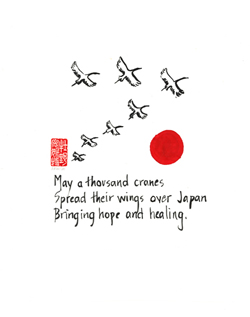Local artist and haiku poet reaches out through her art
The Times-Standard
Eureka, California
March 25, 2011
When she was a girl, Annette Makino spent several months living in Japan with her Japanese grandparents. So when the 9.0 earthquake and tsunami struck the coast of Japan two weeks ago, she felt it personally.
Makino, an Arcata-based poet and artist, was moved to express her sorrow for the people of Japan through her art. The resulting piece is a prayer in the form of a haiku, illustrated with Makino’s Japanese ink painting:
May a thousand cranes
Spread their wings over Japan
Bringing hope and healing.
“My heart breaks for the countless people who have lost their family and friends, their homes, their livelihoods and everything they once knew,” said Makino. “This piece is my prayer for the Japanese people – although they have lost everything, I wish them hope for a better future.”
She explains that the crane can symbolize many things in Japanese culture, including good fortune and longevity. But for her piece, “Prayer for Japan,” she was focused on the story of Sadako, a girl who contracted leukemia following the bombing of Hiroshima. Sadako hoped that if she folded a thousand origami cranes, she would live. Since then, the crane has come to symbolize peace and hope.
Makino has been writing and making art most of her life, but she just started writing haiku and a related form called senryu last summer, when her friend, local artist Amy Uyeki, gave her a book of senryu written by Amy’s Japanese grandmother and illustrated with Amy’s art.
“I discovered this whole new way of writing, where you take an experience from everyday life and strip down and down and down until you get to the essence of things,” said Makino. “It’s a challenge to figure out how to communicate your meaning in just 17 syllables, but when it works, it’s powerful.”
Haiku and senryu share the same structure: Typically, five syllables in the first line, seven syllables in the second line and five syllables in the third, although modern poets often deviate from this form. Haiku are traditionally focused on nature and the seasons, while senryu focus on human nature and are often wry or funny.
An example of Makino’s art illustrates her gentle sense of humor. A dog sits in front of a rain-streaked window, with this poem:
A dark, rain-lashed day
Even the dog won’t go out
He’ll hold it till spring.
In Japanese tradition, haiku are often accompanied by haiga, artwork that complements the words. Once she started writing haiku and senryu, Makino began illustrating her poems with haiga using the traditional Japanese technique of sumi ink painted on rice paper with bamboo brushes.
Makino has just launched a website featuring her Japanese-inspired poems and art atwww.makinostudios.com, with pieces on topics as timeless as the dance between bees and flowers, and as modern as her daughter’s desire to pierce her navel. Makino Studios offers originals and prints of the artist’s work as well as custom pieces created for life passages such as births, weddings and birthdays.
The site also hosts Makino’s new blog, Drawing Breath. In the post accompanying her “Prayer for Japan,” Makino describes her grandparents’ home:
“In my mind’s eye I can still see the traditional gate at the entrance, immensely tall to my 8-year-old eyes,” she writes. “And though Takasaki is not near the sea, I can picture a giant tsunami wave washing over that gate and sweeping through the house, destroying those delicate rice paper screens and everything else.”
Makino has a Japanese father and a Swiss-German mother, and has lived in Europe as well as Japan. She comes to her work with 30 years of experience in writing and graphic design as a communications and outreach specialist for nonprofit organizations, most recently for Internews in Arcata. She has a degree in international relations from Stanford University and has studied drawing, painting and graphic design at Humboldt State University.
On her website Makino writes, “My goal as a writer and artist is to create poems and images that remind us of deeper truths – that there is richness and beauty in imperfection; that the quality of attention we pay every moment determines the quality of our lives; and that through our individual experiences, we can touch on the universal, and remember that we are all connected.”

